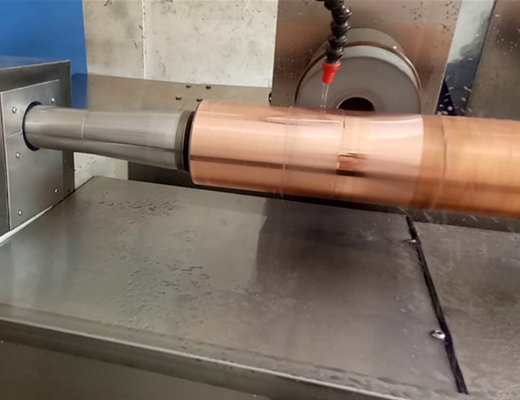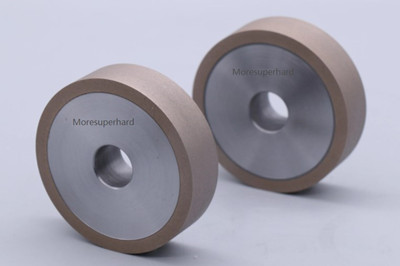

Copper has good ductility, which is easy to cause porosity blockage, so that the grinding wheel loses heat dissipation ability.Then cause the workpiece burn or expansion deformation, belongs to one of the difficult grinding materials.
Understanding Copper
Copper is a soft metal widely used in electrical and plumbing applications, as well as in the production of coins, jewelry, and decorative objects. Its excellent thermal and electrical conductivity make it a popular choice in numerous industries. However, its ductility and low hardness pose challenges during grinding.

Challenges in Copper Grinding
Because of copper’s softness, it tends to generate excessive heat during the grinding process. The heat can lead to discoloration, warping, or even melting of the metal. Additionally, copper’s low hardness increases the risk of surface deformations and imprecise grinding results. Moreover, copper is prone to forming burrs and smearing during grinding, further complicating the process.
Grinding Wheel Selection
Abrasive Material
For copper grinding, diamond wheels are commonly used due to their exceptional hardness and heat resistance. Diamond abrasive grains provide superior cutting abilities while minimizing heat generation, resulting in improved grinding efficiency and reduced thermal damage.
Bonding Material
The bonding material in grinding wheels for copper should be chosen carefully. Resin bonds are often preferred due to their ability to absorb shocks and vibrations, which helps minimize the risk of workpiece deformation. Additionally, resin bonds provide good heat resistance and efficient chip clearance.
Grit Size
The appropriate grit size selection is essential for achieving desired surface finishes. For initial rough grinding, coarser grit sizes (36-60) are recommended to remove excess material rapidly. Subsequently, finer grit sizes (120-320) are used for the finishing process, ensuring smooth and precise surfaces.
Wheel Design
Grinding wheels with an open structure are advantageous for copper grinding. This design facilitates coolant flow and chip clearance, preventing heat buildup and reducing the risk of thermal damage. Wheels with larger pore sizes and wider spaces between grains are typically preferred.
When grinding, the grinding wheel can be selected according to the characteristics of copper.
The main processing properties of copper are as follows:
Grinding properties of copper
1.The grinding wheel is easy to be blocked and the workpiece is heated and deformed
Due to the good ductility of copper, it is easy to cause the blowhole blocking and the grinding wheel loses the heat dissipation ability, thus causing the workpiece to burn or expand and deform.
2.Copper material is easy to adhere, grinding slip, vibration
After grinding, the copper material is easy to adhere to the abrasive grain, so that the abrasive grain loses the grinding force, easy to leave vibration traces on the workpiece.
3.Easy to scratch, improve gloss is not easy
The grinding copper material is easy to stick to the surface of the grinding wheel and cause scratches as the grinding wheel rotates. It is not easy to improve the gloss.
We can improve the pore of its structure, via the treatment of pores can reduce the blockage, grinding heat and improve the adhesion problem.
Through the treatment of pore, can provide the chip hiding space, reduce the scratch problem. And fine grain still has large pores, even fine grain grinding wheel can still make large pores specifications, can simultaneously improve the gloss and avoid blockage, burn deformation!
The grinding wheel with the "pore technology" of both large and small pores can also dissipate heat smoothly with fine grain size, improve the surface roughness and at the same time, do not have to worry about grinding heat problem.
Moresuperhard developed a kind of metal bond diamond wheel to grind brass copper, if you are in need, feel free to contact us.

Conclusion
When it comes to grinding copper, selecting the right grinding wheel is crucial for achieving accurate and high-quality results. The unique characteristics of copper, including its softness and low hardness, necessitate the use of diamond wheels and resin bonds. Proper selection of grit size, wheel design, and adherence to safety precautions will minimize the risk of thermal damage, burr formation, and surface deformations. By following these guidelines, operators can effectively grind copper and achieve the desired surface finishes in various industrial applications.
Semiconductor Industry Solutions
PCD & PCBN Tools Grinding Industry
Diamond Cutting Bruting Polishing
Add: No.171 Zhongyuan Rd, Zhongyuan District, Zhengzhou, 450001, Henan, China
Tel: +86-371-86545906
Phone / Whats App: +86 18339903057
E-mail: [email protected]



